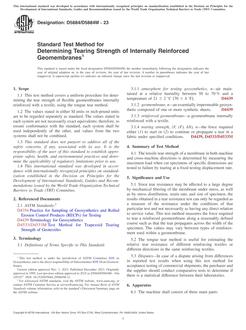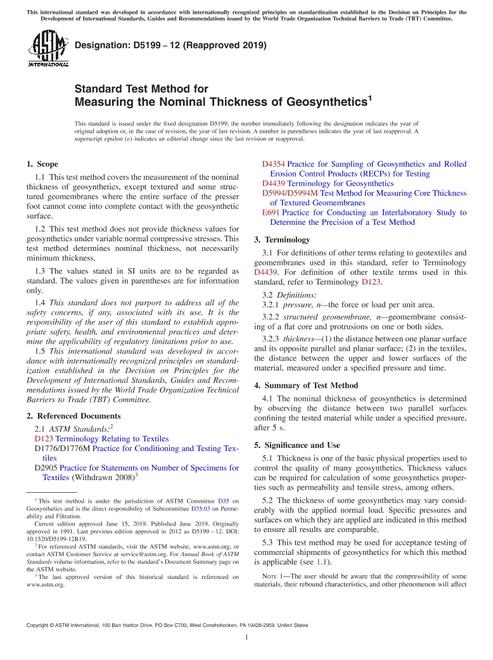-
-
Available Formats
- Availability
- Priced From ( in USD )
-
Available Formats
-
- Immediate download
- $52.00
- Add to Cart
-
- Printed Edition
- Ships in 1-2 business days
- $52.00
- Add to Cart
Customers Who Bought This Also Bought
-

ASTM D6214/D6214M-23
Priced From $55.00 -

ASTM D5884/D5884M-23
Priced From $55.00 -

ASTM D6525/D6525M-18(2023)
Priced From $50.00 -

ASTM D5199-12(2019)
Priced From $42.00
About This Item
Full Description
1.1 This practice is intended for use as a summary of destructive and nondestructive quality control test methods for determining the integrity of field seams used in the joining of flexible sheet materials in a geotechnical application. This practice outlines the test procedures available for determining the quality of bonded seams. Any one or combination of the test methods outlined in this practice can be incorporated into a project specification for quality control. These test methods are applicable to manufactured flexible polymeric membrane linings that are scrim reinforced or nonreinforced.
1.2 The types of field seams covered by this practice include the following:
1.2.1 Thermally Bonded Seams:
1.2.1.1 Hot Air--A seam produced by applying high-temperature air or gas between two polymeric sheet surfaces, thus melting the surfaces, at which time pressure is applied to form a homogeneous bond between the two membrane surfaces.
1.2.1.2 Hot Wedge (or Knife)--A seam produced by melting the two intimate surfaces by running a hot metal wedge between the surfaces followed immediately by pressure to form a homogeneous bond.
1.2.1.3 Extrusion--A bonded seam produced by extruding molten parent material between or at the edge of two overlapped polymer sheet materials to effect a homogeneous melt between the two sheets to be joined.
1.2.2 Solvent Bonded Seams--A solvent is used to soften the surfaces to be bonded, followed by pressure to form a homogeneous bond.
1.2.3 Bodied Solvent Bonded Seams--The parent lining polymer material is dissolved in a solvent that is then applied in the same manner as a straight solvent, thus effecting a homogeneous bond.
1.2.4 Adhesive Bonded or Cemented Seams-- An adhesive system is used to bond two polymeric surfaces together. This system forms an adhesive bond between the sheet materials.
1.2.5 Taped Seams--An adhesive-based tape is placed between two polymer sheet materials forming a surface bond.
1.2.6 Waterproofed Sewn Seams--Seam fabricated by mechanical sewing of the overlapped sheet materials and sealed with an appropriate sealant as recommended by the sheet manufacturer.
1.3 The values stated in inch-pound units are to be regarded as the standard.
1.4 This standard may involve hazardous materials, operations, and equipment. This standard does not purport to address all of the safety concerns, if any, associated with its use. It is the responsibility of the user of this standard to establish appropriate safety and health practices and determine the applicability of regulatory limitations prior to use.
Document History
-
ASTM D4437/D4437M-16(2023)
Standard Practice for Nondestructive Testing (NDT) for Determining the Integrity of Seams Used in Joining Flexible Polymeric Sheet Geomembranes- Most Recent
-
ASTM D4437/D4437M-16(2018)
Standard Practice for Nondestructive Testing (NDT) for Determining the Integrity of Seams Used in Joining Flexible Polymeric Sheet Geomembranes- Historical Version
-
ASTM D4437/D4437M-16
Standard Practice for Non-destructive Testing (NDT) for Determining the Integrity of Seams Used in Joining Flexible Polymeric Sheet Geomembranes- Historical Version
-
ASTM D4437-08(2013)
Standard Practice for Non-destructive Testing (NDT) for Determining the Integrity of Seams Used in Joining Flexible Polymeric Sheet Geomembranes- Historical Version
-
ASTM D4437-08
Standard Practice for Non-destructive Testing (NDT) for Determining the Integrity of Seams Used in Joining Flexible Polymeric Sheet Geomembranes- Historical Version
-
ASTM D4437-99
currently
viewing
Standard Practice for Determining the Integrity of Field Seams Used in Joining Flexible Polymeric Sheet Geomembranes- Historical Version





